Five places to discover Charles Dickens’ world in London
Get in the spirit of Scrooge and explore Charles Dickens' London
By Charlie Walker | Updated Mar 1 2022

Bleeding Heart Yard
Not only does Bleeding Heart Yard have a wonderfully evocative name, it has a wonderfully evocative myth, too. The Devil, so the story goes, tore seventeenth century Lady Elizabeth Hatton limb from limb in the yard, leaving her heart upon the ground still pumping blood. It’s more likely - and more prosaic - that the little square’s name comes from a pub formerly located there. In Dickens’ time, Bleeding Heart Yard was a tiny working-class community, ‘inhabited by poor people, who set up their rest among its faded glories, as Arabs of the desert pitch their tents among the fallen stones of the Pyramids; but there was a family sentimental feeling prevalent in the Yard, that it had a character.’ Dickens made Bleeding Heart Yard an impoverished but cheerful little community in Little Dorrit, a striking contrast to the immiserating conditions of the Marshalsea Prison. Today Bleeding Heart Yard is a pleasant little oasis in the heart of busy Clerkenwell, and boasts an excellent pub and restaurant.
Marshalsea Debtors’ Prison
Little beyond a plaque on a brick wall remains to commemorate the location of the Marshalsea Prison, the most infamous of England’s debtor’s prisons and the one where Dickens’ father was imprisoned for fourteen weeks in 1824 for a debt to a baker. The Marshalsea was run for profit, which meant that debtors sent there generally wound up amassing debt rather than paying off that which they’d previously accrued. A 1729 Parliamentary Committee noted that upwards of 300 people starved to death there over a three month period, but the prison was not decommissioned until 1842. Dickens made the Marshalsea the centrepiece of Little Dorrit, basing his work off his own experiences with the prison. The location is worth visiting both for its own history and because it is only a short walk away from the George Inn (77 Borough High Street), which Dickens visited regularly, and from perennial foodie favourite Borough Market.
Lincoln’s Inn Fields and Fleet Street
Most of the legal action in Bleak House occurs in and around Lincoln’s Inn Fields, where lived the scheming lawyer Tulkinghorn: ‘Here, in a large house, formerly a house of state, lives Mr Tulkinghorn. It is let off in sets of chambers now, and in these shrunken fragments of its greatness lawyers lie in maggots in nuts. David Copperfield’s great-aunt Betsey Trotwood also lived in the area (and you can visit the pub named after her on Farringdon Road). A few streets southwest of Lincoln’s Inn is the Old Curiosity Shop, at 13-14 Portsmouth Street, nestled amongst the buildings of the London School of Economics. Although not called The Old Curiosity Shop in Dickens’ time, the building has stood since the sixteenth century, and may have been Dickens’ inspiration. A short walk east along Fleet Street brings one to Ye Olde Cheshire Cheese, a wonderfully atmospheric pub dating from 1667, which Dickens himself frequented and alluded to in A Tale of Two Cities.
Saffron Hill (Clerkenwell)
Of all Victorian London’s many infamous slums, perhaps none was better known or worse regarded than the ‘little Hell’ Saffron Hill. Dickens set part of Oliver Twist in there, locating Fagin’s hideout on Field Lane (Turnmill Street and Clerkenwell Road): ‘a dirty and more wretched place he [Oliver] had never seen. The street was very narrow and muddy, and the air was impregnated with filthy odours.’The river Fleet, which had become an open sewer by the eighteenth century, was covered over in Dickens’ time. It runs beneath the streets here - one of the great symbolic ironies that Dickens exploited in setting his best-known tale about the perils of industrialism and the evil of the Poor Laws. The river can still be heard through a grating in front of the Coach Pub.
Covent Garden and the Seven Dials
The Covent Garden area is bursting with Dickensian interest. Not only did Dickens live and run his newspaper All the Year Round from the upper stories of number 26 Wellington Street (now the Charles Dickens Coffeeshop), he also set portions of many of his novels in the area. Arthur Clennam (Little Dorrit) lived in a dreary little flat in Covent Garden; Lady Deadlock (Bleak House) died of exposure on the grave of Captain Hawdon in a cemetery now turned into a playground, off Crown Court. The Seven Dials area was another of Victorian London’s famous slums, and Dickens immortalized it in his essay ‘Seven Dials’ in Sketches by Boz. ‘The streets and courts dart in all directions,’ Dickens described, ‘until they are lost in the unwholesome vapour which hangs over the housetops, and renders the dirty perspective uncertain and confined.’ The poor, he continued, are ‘heaped upon the floor like maggots in cheese.’ Although today the Seven Dials is alive with theatres, restaurants, and high-end boutiques, its streets remain labyrinthine and its architecture retains much of its antique flavour.